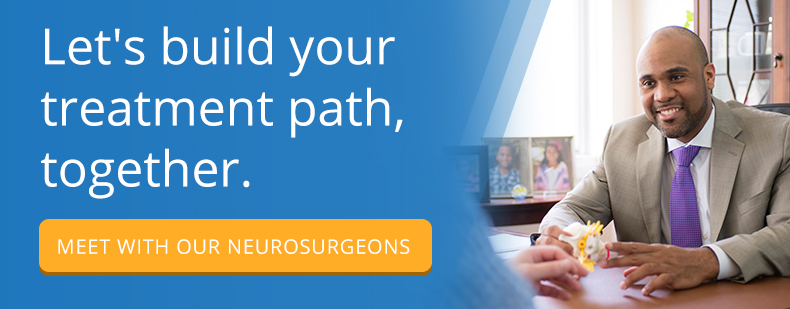Why You May Need Chiari Malformation Surgery
Not everyone who has a Chiari malformation requires surgery. In fact, most people with a Chiari I malformation live their entire lives without discovering it. In some symptomatic cases, though, Chiari malformation surgery offers the best way to prevent progressive neurological problems.
Chiari malformations can cause you to experience headaches and neck pain that make daily activities difficult. Since the condition affects the brain and spinal cord, you may also experience neurological symptoms like difficulty swallowing, muscle weakness/numbness, balance issues or loss of your fine motor skills, which can make it difficult to perform everyday activities like writing, cooking or even tying your shoes.
Some Chiari malformation patients have sensory symptoms like vertigo, tinnitus (ringing in the ear), hearing loss, blurred vision and double vision. You may even experience insomnia or sleep apnea.
To put it simply, this condition can lead to symptoms that make life difficult. If you find that you cannot manage the symptoms, then you should find a doctor who can correct the problem with Chiari malformation surgery.
Surgical Treatment Options for Chiari Malformation
Neurosurgeons who specialize in Chiari malformation surgery should be able to offer both traditional and minimally invasive options when treating your condition. Neurosurgeons who have been trained in minimally invasive techniques can usually offer solutions for Chiari malformation that do not require as lengthy a recovery time as traditional operations. Minimally invasive techniques can also prevent blood loss during surgery and decrease your post-operative discomfort.
Minimally Invasive Surgical Options
Minimally invasive surgical options utilize microscopic visualization and specialized instruments, allowing the surgeon to make smaller incisions to access treatment sites. Many patients who are candidates for traditional surgical options will also be eligible for minimally invasive procedures, which may be preferred because of the reduced pain, bleeding and healing time. As a patient, you can still expect to spend a several days in the hospital, and have activity restrictions in the following weeks.
One option for surgical treatment for Chiari malformation is minimally invasive Chiari decompression. In this procedure, the surgeon creates a small incision at the back of your head, providing access to the rearmost area of your skull and uses special instruments to shave away part of the bone and open the dura, creating more room for your brain inside to alleviate pressure.
Non-dural opening posterior fossa decompression is a second form of minimally invasive Chiari malformation surgery that is commonly used. The surgeon specifically creates space within the posterior fossa of the skull, where the cerebellum sits. This increased space can help provide relief from the symptoms you have experienced as a result of your malformation.
Neuromonitoring is typically performed in conjunction with these procedures, which helps the surgeon determine intraoperatively whether the surgery has achieved enough decompression. In this technique, a technician in conjunction with a neurologist monitors the activity of specific nerves to assess their function, providing the surgeon real-time information during surgery.
Traditional Surgical Options
Not all patients will be candidates for minimally invasive Chiari malformation surgery, in which case traditional surgical options may be more appropriate. The main difference is that traditional Chiari malformation surgery requires a larger incision, more tissue dissection, requires more time under anesthesia, and is more invasive in nature, resulting in longer hospitalizations, recovery time, and more pain medication. However, your surgeon will take all steps possible to ensure your surgery and recovery are as comfortable as possible.
Dural Opening Chiari Decompression
The traditional Chiari malformation surgery is dural opening Chiari decompression. This procedure is similar to, and the predecessor of, minimally invasive Chiari decompression surgery. Following dural opening Chiari decompression, you can expect to spend up to a week in the hospital, followed by approximately six weeks of home recovery.
In this process, the surgeon will actually remove an entire section of bone, as well as the dura, the membrane that covers the brain. In place of the original dura, he or she will place a patch made of natural or synthetic materials, which will expand the intracranial space and help accommodate your brain, creating space and relieving pressure. The soft tissues are then carefully repaired.
Cervical Laminectomy
Another procedure which is commonly used, often in conjunction with decompression surgery, is cervical laminectomy. In this procedure, the surgeon will remove a small section of bone from your uppermost vertebrae, creating space in the spinal canal for your spinal cord. This can be particularly helpful if the spinal cord has been impinged by your Chiari malformation.
Transnasal and Transoral Decompression
Transnasal and transoral decompression surgeries are less commonly used, and your surgeon may recommend one or the other if you have additionally bony malformations in addition to your Chiari malformation. In these procedures, the surgeon will access the site via your nose or mouth and will remove bone and/or soft tissue to increase space and alleviate pressure. Transnasal and transoral surgeries are often performed in conjunction with other procedures to obtain maximum results.
Spinal Fusion
Spinal fusion is another procedure that may be used in conjunction with decompression surgery and may be required if your spine requires additional stabilization because of your particular malformation. This treatment reinforces the spine by fusing the skull with the uppermost vertebrae of the neck, permanently enhancing stability and helping ease symptoms.
CSF Diversion
Sometimes cerebrospinal fluid (CSF) builds up with the skull causing or contributing to your Chiari, or accumulates in the spinal cord because of the Chiari malformation. This can lead to symptoms that affect your daily activities. One way to help alleviate these symptoms is to remove the fluid, via a procedure called CSF diversion.
In a CSF diversion treatment, the surgeon will place a shunt that redirects the fluid from the build-up site to another area of the body, such as the abdomen, where it can simply be reabsorbed by the body’s natural systems. The procedure does require a short hospital stay, as well as follow-up visits to monitor progress and recurrence.
What to Expect During Your Recovery
Your recovery timeline from Chiari malformation surgery will vary according to several factors. Most patients spend one to three days in the hospital, where the medical staff can monitor their immediate recovery. After getting discharged from the hospital, though, you may need to recover at home for up to twelve weeks. If you undergo minimally invasive surgery, then you should expect a slightly shorter recovery time.
During your home recovery, you should refrain from all strenuous activities.
You may experience some pain during the first couple of weeks. Your doctor can help control the pain with prescription medication. It is also important to keep the incision site clean until it heals.
Some patients with pre-existing problems as a result of their Chiari malformation may need physical therapy to help them recover lost fine motor skills. Your Chiari malformation doctor should have references to physical therapists who have experience working with people who have your condition.
There are many ways to treat your Chiari malformation, and your surgeon will recommend the Chiari malformation surgery that he or she believes best fits your individual condition, taking into account your symptoms, anatomy and any additional health conditions you may have.
Regardless of which procedure you will be undergoing, it is important that you are comfortable not only during but also before your surgery. If you find that you still have questions, or perhaps you have new questions that have come to mind, write them down now and bring them up with your doctor at your next appointment. Having peace of mind can help reduce the stress of an upcoming surgical procedure, allowing you to focus more on your recovery when it matters most.


